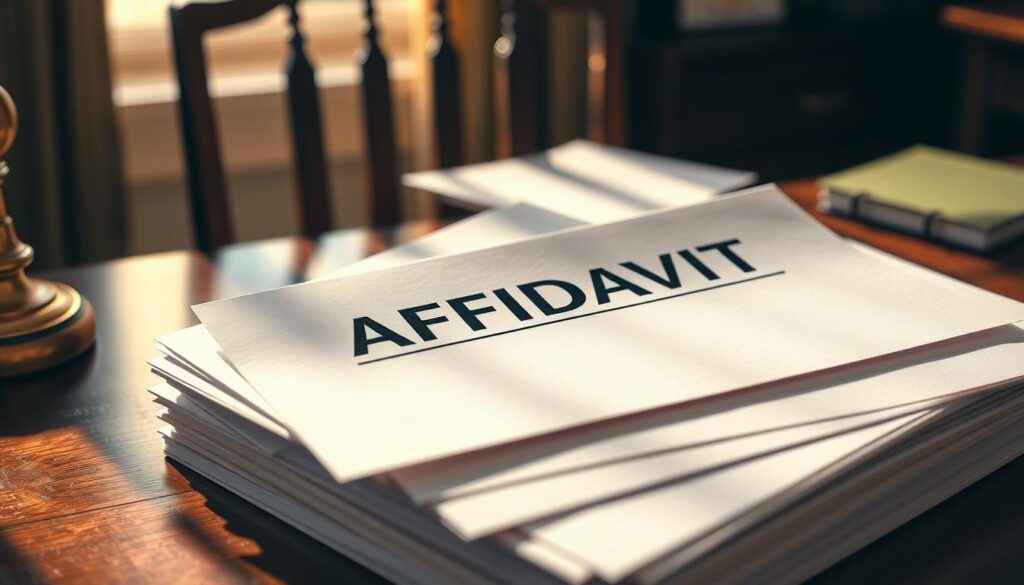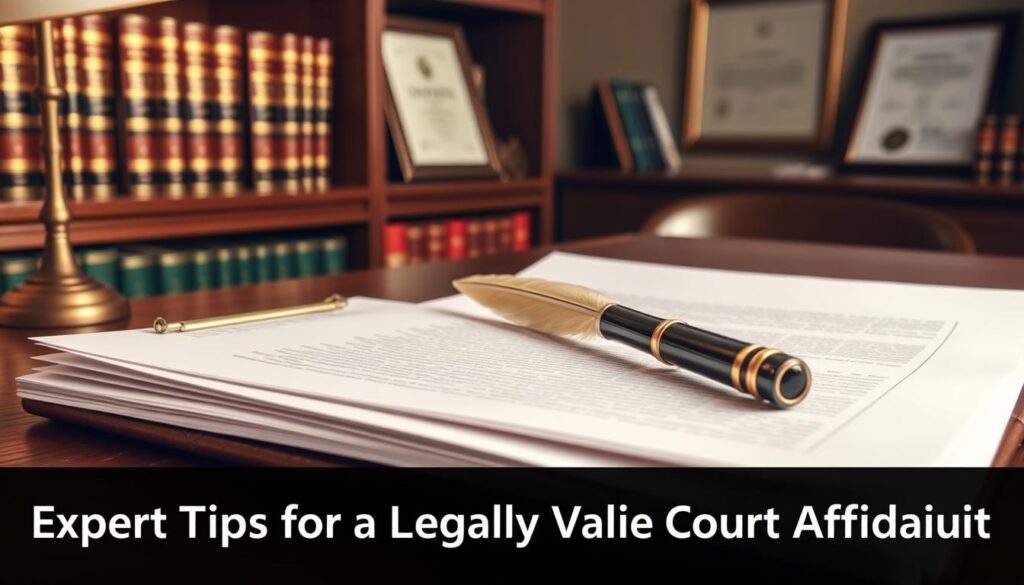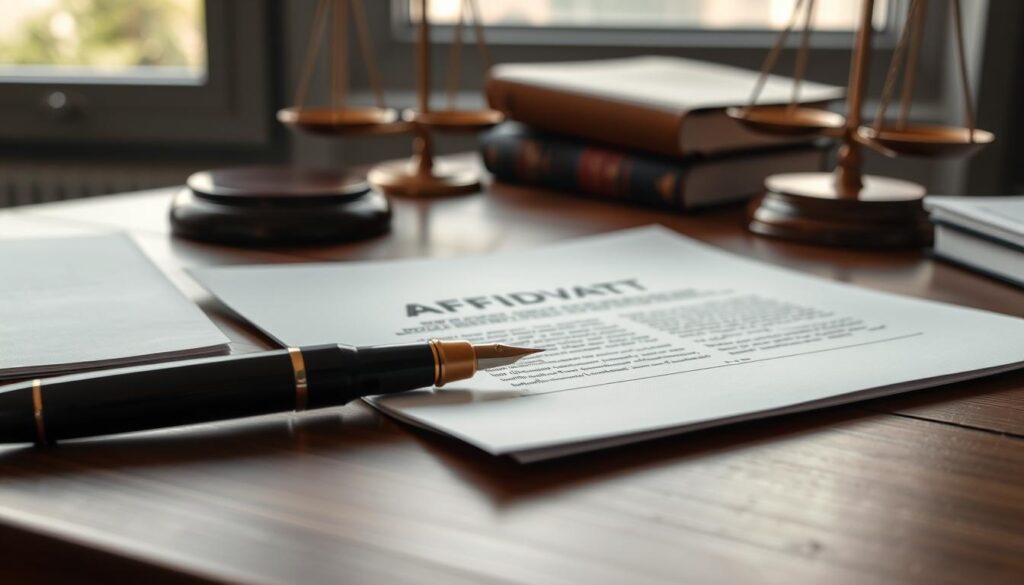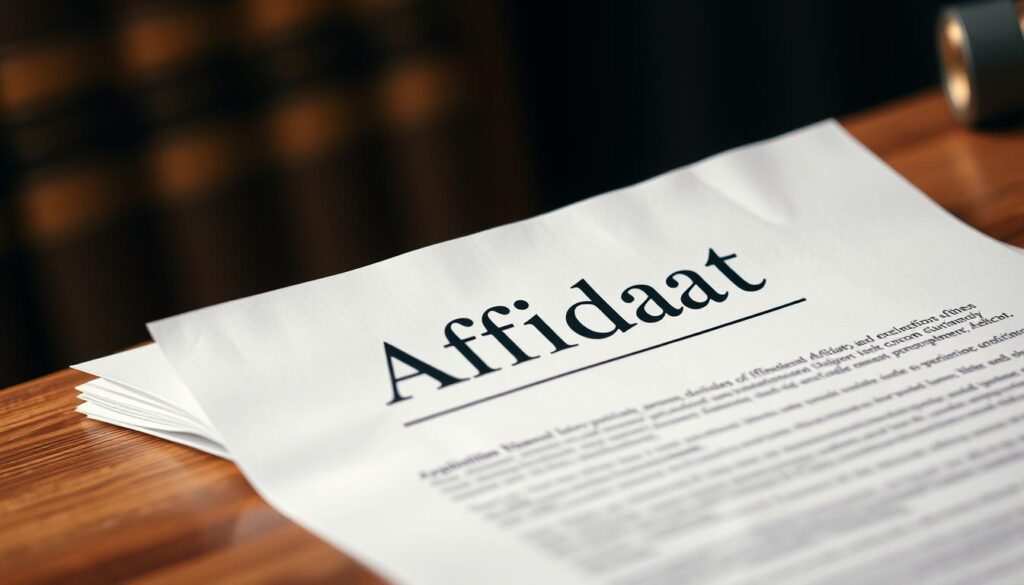Affidavit for Court Matters
Surprising fact: over 70% of civil filings in India include a sworn statement that shapes how a case unfolds.
This page explains what an affidavit is and why such written statements matter in legal proceedings. A deponent signs this document before an authorised officer, such as a notary or commissioner for oaths.
In Indian practice, affidavits follow Section 139 and Order XIX of the Code of Civil Procedure, 1908. They are not automatically evidence under the Indian Evidence Act, 1872 unless law or a judge permits it.
False statements can attract perjury charges, so telling the truth is essential. The guide that follows will show who the person making the declaration is, what the attesting officer records, and how these papers may be used alongside oral testimony.
Key Takeaways
- An affidavit is a sworn written statement used in many legal filings.
- The deponent signs before an authorised officer who attests execution.
- Under Indian law, these papers may not be evidence unless allowed.
- Perjury rules apply—accuracy and truth are compulsory.
- Understand procedural use to avoid delays or rejection at filing.
Understanding affidavits in India: what they are and why courts rely on them
In India, written sworn statements serve as a practical means to present facts in proceedings.
How they work: Under Section 139 and Order XIX of the Code of Civil Procedure, a signed statement records facts efficiently. The document puts a person’s name, standing and factual points on the record while binding the deponent by oath.
Legal limits: Such papers are not always treated as formal evidence under Section 3 of the Indian Evidence Act unless a specific order allows it. When allowed, the opposite side may seek cross‑examination.
“Sworn statements speed case management, but judges may require live testimony where credibility or detail matters.”
- Keep the purpose narrow and use numbered paragraphs.
- Distinguish facts from those based on information or belief.
- Use clear exhibits and a concise verification at the end.
| Purpose | Typical use | When oral evidence is needed |
|---|---|---|
| Record facts quickly | Support interim relief | If credibility is contested |
| Verify identity or title | Attach documentary proof | When detail requires cross‑examination |
| Preserve accountability | Provide sworn statement of knowledge | Judge orders viva voce evidence |
Court Affidavit FAQs: Everything You Need to Know
When a written declaration is sworn before an authorised officer, it becomes a legal document that binds the deponent. This sworn statement must state facts clearly and be signed in the officer’s presence.
What is the deponent and the person making this statement?
The deponent is the person making the affidavit and is responsible for accuracy. Give your full name, role in the matter and contact details so the filing official can place the paper correctly.
Affidavit versus declaration under Indian law
An affidavit carries the solemnity of oath or affirmation and may attract perjury if false. A declaration can suffice in some administrative contexts, but law often prefers the sworn form where rules demand it.
When are these papers used?
Common uses include support for interlocutory applications, verifications, and correcting a name or address. In many proceedings, affidavits streamline issues where live testimony is unnecessary.
- State facts from knowledge as “I say”;
- When reporting others’ information, note the source;
- Use the sworn form if rules require it to avoid rejection.
Who can witness and take your affidavit in India
An authorised officer must attest execution and record specific details when a sworn statement is signed for legal filing.
Commonly authorised officials include a notary public, a magistrate or a commissioner for oaths. In many non‑judicial matters a notary appointed under the Notaries Act, 1952 will attest the document. For matters requiring a judicial form, an Oath Commissioner or magistrate may be necessary.
Authorised affidavit takers and attestations
Practice tip: appear in the officer’s presence with formal ID and any exhibits you will annex. Remote witnessing may be allowed only where rules permit for electronic execution.
What the authorised officer must record
The attesting officer must note their full name, professional address and authority to act. They should record the place and date and apply their signature and seal. Each page should be signed or initialled by the deponent and mirrored by the officer.
“Correct attestation and clear exhibit notes reduce risks of registry objections and rejection.”
| Officer | Recorded details | Typical effect |
|---|---|---|
| Notary | Name, address, date, seal | Suitable for non‑judicial filings; notarisation recognised by many registries |
| Commissioner for oaths / Oath Commissioner | Name, authority, place, date | Used where judicial formality is required under an order |
| Magistrate | Name, rank, official address, signature | Preferred where higher court formalities or verification by an attorney may be relevant |
- Mark and sign exhibits with exhibit notes cross‑referenced to paragraphs.
- Avoid missing attestations, incomplete officer details or illegible pages.
- Confirm local registry requirements before execution to prevent delays.
The process to make and sign an affidavit correctly
Start the making affidavit process by confirming the correct form and the competent forum for filing. Using the wrong format can delay registry acceptance and trigger objections.
Before you start
Check local requirements and any prescribed form the registry accepts. State your full name, role in the matter and use numbered paragraphs so facts match annexures.
Signing and initialling
Sign each page and initial every alteration in the presence of the authorised officer. The officer should also sign or initial pages to maintain integrity and confirm the signature.
Exhibits and annexures
Attach clear exhibit certificates that identify each document, refer to the relevant paragraph, and bear signatures from both the deponent and the officer. Carry originals for verification and keep a duplicate set for your records.
Completing the jurat
Record the place, date, officer’s name, address and authority in the jurat, and ensure the officer signs and seals the jurat. Where rules permit remote execution by audio‑visual link, state this in the jurat and confirm any scanned copy used for attestation.
- Confirm the right form and forum before drafting.
- Keep the document legible, paginated and free from overwriting.
- Match statements to annexed documents for easy reference.
Oath or affirmation, interpreters and accessibility
How an oath differs from an affirmation. An oath invokes a religious or spiritual pledge; an affirmation is a secular promise. Both carry equal legal effect and bind the deponent by truthfulness.
Suggested wording: “I, [name], solemnly and sincerely affirm that the contents of this affidavit are true and correct.” Use words you can honestly state and that reflect your belief in the accuracy of the text.
Interpreters and translations
If English is not your preference, engage an interpreter. The interpreter must take an interpreter’s oath and provide a faithful translation.
When the main document is in another language, attach an English translation and an interpreter’s supporting affidavit. This step helps registries and judges read the record without delay.
Reasonable adjustments for disabilities
Reasonable adjustments are permitted. Examples include sign language interpretation, reading the text aloud, or explaining contents to an illiterate person.
The authorised officer should certify that the person appeared to understand the statements and that the oath or affirmation was administered in their presence. Remote administration by audio‑visual link is allowed where rules permit; the jurat must record this.
“The oath or affirmation is a formal promise; how it is given should reflect personal belief and practical need.”
| Issue | Practical step | Recorded in jurat |
|---|---|---|
| Choose oath or affirmation | State prescribed words audibly or use permitted adjustment | Officer notes wording and deponent’s belief |
| Interpreter needed | Interpreter takes oath and translates; attach interpreter affidavit | Officer records interpreter’s role and signature |
| Disability adjustment | Provide sign language or read aloud; certify understanding | Officer certifies adjustment and that signing occurred in presence |
Common types and uses of affidavits you may need

Different sworn papers address issues from identity theft reports to proof of residence.
Name change and address affidavits. For a formal change of name, many persons execute a sworn statement and often publish the change in two newspapers. An address or residence statement helps with KYC and local verification when updating records.
Identity theft and lost document affidavits
Identity theft reports are used to notify banks and creditors about unauthorised activity and to seek blocking or reversal of transactions.
A lost document statement supports reissue requests for passports, marksheets or IDs and protects against misuse.
Power of attorney and property ownership
Use a power attorney affidavit to confirm an agent’s authority and that it has not been revoked. Property ownership affidavits can attest title issues, possession facts, or the chain of events affecting property transfer.
Marriage, firstborn child, debt and employment uses
Marriage affidavits (under the relevant marriage Act) confirm date and place of marriage. Firstborn child statements are common as proof for school admissions.
Short affidavits also verify employment facts, debt ledgers or the absence of criminal records for background checks.
| Type | Typical use | Execution |
|---|---|---|
| Name/Address | Record change, KYC | Notary or state stamp paper |
| Identity theft / Lost document | Bank notice, reissue | Notary; court form where required |
| Power attorney / Property | Support agent actions | Notarised; judicial form if filed in a court |
Practical tip: select the correct forum and annex supporting exhibits. A properly drafted statement with clear paragraphs and annexures helps the registry accept the document for its intended purposes.
Format and content: legal requirements your affidavit must meet
A properly framed sworn statement follows a strict layout so registries can accept it without objection.
Start with identification: open with the cause title, case number, parties and your full name, parentage, occupation and residence. This anchors the document to the correct record and avoids misfiling.
Structure, paragraphing and verification statements
Break facts into short, numbered paragraphs. Each paragraph should contain a single point and reference any exhibits by number.
End with a clear verification. State which paragraphs are true to your knowledge, which are based on information and which you verily believe. This distinction is essential for admissibility and later cross‑examination.
Statements of knowledge, information and belief: correct phrasing
Use precise wording: “I say that…” for matters from your knowledge. For sourced facts use “I am informed by [source] and verily believe that…”. Avoid vague or sweeping assertions.
Judicial versus non‑judicial affidavits and stamp paper requirements
Choose the right form. Judicial statements usually use judicial paper with applicable fee stamps and an Oath Commissioner. Non‑judicial statements sit on state stamp paper and are notarised by a notary.
“Sign each page and have the officer record place, date and authority; misstatements may attract penalties under IPC provisions.”
Notarisation, attestation and remote execution

Notarisation and remote attestation rules determine how a sworn paper is validated for filing. Non‑judicial papers are usually notarised by a notary under the Notaries Act, 1952. Judicial filings are typically attested by an Oath Commissioner.
Do you need notarisation or simple attestation?
Confirm the registry’s requirement before execution. A notary will apply a seal, sign, and record the act in their register.
Good practice: sign every page, initial any changes and complete a clear jurat with date, place, officer’s name and authority.
Audio‑visual link execution and e‑signatures: current practice
Some jurisdictions allow execution by audio‑visual link with electronic signature. When used, the jurat must note that the deponent signed and swore via A/V and that scanned copies were relied on for attestation.
Verify identity robustly in any remote process. Keep ID ready for display and retain proof of the session (screenshots, meeting ID or an officer’s confirmation).
- Ensure annexed documents are legible scans and exhibit certificates bear the same date as execution.
- Initial all alterations and have the officer mirror those marks to protect integrity.
- A sensitive matter may prompt a preference for in‑person attestation by the court or registry.
What happens after filing, and how courts treat affidavit evidence
Filing places the written declaration before the judge, where it may be relied on for specific factual points. Once on the record, the paper becomes part of the case file and can shape directions on interim relief.
After you file: how your affidavit is used in the case
The judge will read the statement and may accept it for narrow issues permitted by law or by order. Expect directions that require attendance for oral testimony or cross‑examination.
Practical steps:
- Keep dated copies and note the time of submission.
- Be ready to attend court or a hearing at short notice.
- Label exhibits clearly and prepare a contents list for quick reference.
- File any counter‑affidavits or rejoinders as directed to maintain consistency.
Validity, admissibility and perjury risks for false statements
The Evidence Act does not automatically treat such papers as evidence; Order XIX allows courts to accept sworn proof in limited contexts. Parts unsupported by exhibits or that are speculative may be ignored.
“False sworn statements can trigger prosecution under IPC provisions and court‑initiated steps under CrPC.”
| Issue | Likely direction | Effect on case |
|---|---|---|
| Factual claim with exhibits | Document relied upon; may avoid oral proof | Weight increases if corroborated |
| Disputed credibility | Deponent called for cross‑examination | Oral testimony may be required |
| False or misleading statement | Court may order inquiry or refer for prosecution | Risk of penal proceedings and weight loss |
Costs and fees: what you can expect to pay
Understanding likely charges for stamps, notarial work and drafting prevents surprises during filing.
Non‑judicial filings usually sit on stamp paper whose value varies by state and by document type. Judicial filings often need court fee stamps as set out in the registry schedule.
Notary charges are typically modest and regulated. Ask for a receipt and check the notary’s register entry and seal before you leave.
Drafting fees depend on complexity. An advocate may charge more when collating many exhibits or preparing sworn statements for contested matters.
- Budget for stamp paper or court fee stamps depending on your filing.
- Request official receipts for notary services and certs.
- Factor in printing, certified copies and true copy stamps.
- Check whether foreign use needs apostille or higher attestation.
| Item | Typical cost driver | When required |
|---|---|---|
| Stamp paper / court stamp | State schedule; document type | Non‑judicial or judicial filings |
| Notary fee | Fixed/regulatory; attestation abroad raises cost | Documents needing notarisation |
| Drafting / advocate | Complexity and time | When legal drafting or verification by an attorney helps |
Practical tip: arrive with correct ID and exhibits to often get same‑day execution and to reduce repeat visits when you get affidavit for filing.
Conclusion
,
Good preparation before execution prevents avoidable delays at filing.
Key takeaway: a well‑drafted affidavit with clear identification of the person making, numbered paragraphs and a verification that separates knowledge from belief meets legal requirements and shortens time in a proceeding.
Pick the correct form and officer (notary or Oath Commissioner), mark exhibits, sign each page and complete the jurat. For sensitive matters — property, power attorney or identity theft — engage an attorney for drafting and review.
Final steps: check stamps, ensure presence for attestation, file on time and keep certified copies. Accurate statements matter; an affidavit must be truthful because falsehoods carry serious risk.
FAQ
What is an affidavit and who is the person making the affidavit (deponent)?
An affidavit is a written statement sworn or affirmed to be true before an authorised officer. The person making it is the deponent. The deponent signs the document, confirms the facts are true to the best of their knowledge, and gives their name and address. The jurat records the place, date and the officer’s authority.
How does an affidavit differ from a declaration under Indian law?
A declaration is similar but may be used where a formal oath is not required. An affidavit involves swearing or affirming before an authorised officer and carries clear consequences for false statements. Declarations can sometimes be self-declared statements without a jurat, but their admissibility and weight vary by forum.
When are affidavits used in proceedings and other legal purposes?
You use affidavits to present factual evidence, support interim applications, verify pleadings, prove identity or address, and attach exhibits. Courts, tribunals, banks and public authorities accept affidavits for varied administrative and legal processes.
Who can witness and take your affidavit in India?
Authorised affidavit takers include notaries, magistrates, judicial officers, and those designated as oath commissioners or authorised officers under local rules. Some government officers and embassy officials may also authenticate statements for overseas use.
What must the authorised officer record when taking an affidavit?
The officer must record their name, office address, the authority under which they act, the place and the date of attestation. They must also sign and stamp the jurat and confirm they administered the oath or accepted the affirmation.
What should you check before you start drafting an affidavit?
Confirm the correct forum, required format, any court rules, and whether a specific form or heading is prescribed. Identify which facts you can swear to from personal knowledge and which must be stated on information and belief. Check fee and stamping requirements for your state or tribunal.
How do you sign and initial an affidavit correctly?
Sign the final page in the presence of the authorised officer and initial every page. Avoid blank spaces and make no unauthorised alterations; if you change text, strike through, add the correction, and have the authorised officer and you initial the amendment.
How should exhibits and annexures be attached and certified?
Attach exhibits as clearly labelled annexures and refer to them in the body. Provide a certificate or list stating the exhibit number and description. The authorised officer or your witness may need to attest the annexures as true copies where required.
What details complete the jurat on an affidavit?
The jurat should show the place and date of attestation, the deponent’s signature, the officer’s signature, stamp, and the officer’s designation. For electronic execution, include the method used and any digital signature details as allowed by rules.
What is the difference between taking an oath and making an affirmation?
An oath requires invoking a religious text or deity; an affirmation is a secular promise to tell the truth. Both carry the same legal consequences. You may choose affirmation for religious or personal reasons, and the authorised officer will record which option you selected.
Can you use an interpreter or request adjustments if you have a disability or language barrier?
Yes. Use an interpreter if you do not understand the language of the document, and request reasonable adjustments for disability, such as assisted signing or audio-visual support. The officer should record the presence of an interpreter and their details in the jurat.
What are common types of affidavits you may need?
Typical types include name-change affidavits, residence or address proofs, lost-document or identity-theft affidavits, power of attorney and property affidavits, marriage or birth-related affidavits, and affidavits supporting employment or financial claims.
How should the content and structure of an affidavit be arranged?
Use clear numbered paragraphs, factual statements in chronological order, and a concise verification clause at the end stating the truthfulness. Distinguish facts from opinions and avoid legal argument within factual paragraphs.
How do you phrase statements of knowledge, information and belief correctly?
State facts you personally know as “I state on oath that…”. For second-hand information, use phrasing such as “I believe on the basis of information received that…”, and identify your sources where possible. Avoid speculative language.
Are there differences between judicial and non-judicial affidavits and stamp paper needs?
Judicial affidavits are for court proceedings and follow court rules; non-judicial affidavits serve administrative or private purposes and may require stamp duty under local law. Verify state stamping requirements and whether a court exempts certain affidavits.
Do you need your affidavit notarised or simply attested?
Notarisation is often preferred and may be required for documents used outside India or by some authorities. For many court filings, attestation by an authorised officer within the court’s rules suffices. Check the receiving authority’s requirements.
Can affidavits be executed via audio-visual link or with e-signatures?
Some jurisdictions now permit audio-visual execution and electronic signatures subject to procedural rules. Ensure you follow the current guidelines and confirm acceptance with the receiving court or authority before relying on remote execution.
What happens after you file an affidavit and how will the court treat your evidence?
After filing, the affidavit becomes part of the record and may be used for evidence, cross-examination, or referred to in orders. The court assesses credibility and admissibility; hearsay or unsupported statements may carry limited weight.
What are the risks of false statements and perjury?
Making a false statement in an affidavit can lead to contempt, perjury charges, fines or imprisonment. Always state only what you know or clearly label what is on information and belief to minimise risk.
What costs and fees should you expect for preparing and filing an affidavit?
Expect drafting fees for a lawyer, stamp duty where applicable, notary or attestation charges, and court filing fees. Costs vary by state and complexity; obtain a fee estimate before proceeding.






